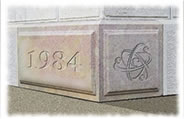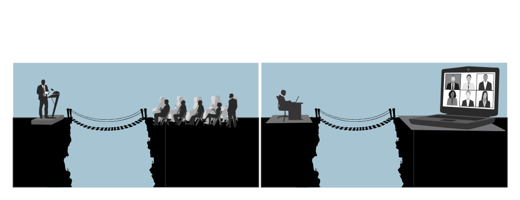An “Art” to Beginning
In the beginning, there was a bad joke.
And no one remembers what came after…
There’s an awkward, dark moment before a presentation begins – whether in person or virtual… Disaster lurks there. The audience is wondering how to spend the next forty minutes…
Not everyone in that vast audience or Zoom call is silent yet… They’re still scattered. If in-person, they’re still buzzing, shifting, looking around, sizing up the location, their seat, their colleagues, the program. If it’s virtual, they’re trying to connect, find the video button to turn on their camera and quickly find the mute button to silence the dog barking in the other room. They’re bored… Maybe a little bit cranky. Then comes the not too well executed introduction, given by a not too practiced public speaker. So. We’re off to a shaky start.
Which is why there is an ART to Beginning.
We have to capture everyone’s attention. Get them totally engaged, committed to what we’re doing, interested in what’s about to happen, and happy to participate.
Everyone harbors their own private fantasy about telling a perfect out-of-the-park joke, which lays everyone in the aisles. Then going home, buoyed by the acclamation, a victorious speaker… And the chances of hitting that home run with the first sentence are astronomically low. (A lot of those meetings are sadly, dead! with the introduction…) So the best attempt is not usually a joke, although a little self-deprecation or a bit of a playful tease might be in order.
But they’re simply not with you yet. You have to realize that they are at dead stop, and they have to hear or see something that moves them from sheer boredom to even mild interest… Once their attention is up, you can direct it where you’d like it to go.
The secret of Beginning is that a great deal has to happen in a very short time! Oh, and without anyone really noticing the nearly invisible connections and bridges between Boredom, Interest, Curiosity, Consideration, and Acceptance.
(Boredom) The purpose of the walk to center stage — or virtual appearance on the center screen — is to announce your presence and allow the audience to focus. (Mild Interest) Then you give them an Opening: an easy to grasp bit of poetry, a story, a quote, a song, a dance, to gently engage their (Curiosity) as they wrap their head around the significance of this bit of information, and what it might portend for the rest of the experience.
With the Opening behind them, they’re now ready to get the big idea of the presentation, “The Subject.” So you tell them: “With that in mind, we’re here to discuss XYZ!” (Consideration) To make this a little easier to track, I’d like to present you first with some Background, then move directly to the Analysis of the Problem, then move on to our Recommended Solution.” (Acceptance… At least primary Acceptance…)
There! From Boredom to Acceptance in a few swift, apparently effortless steps.
Done well, the Beginning of the Presentation (Speaker Intro, Opening, Subject & Agenda) appears to be next to nothing, yet it captures attention, creates a focus, then a plan for the discussion, and gets people digging right into the first area of concern without them really knowing all the work required to make that process appear invisible and effortless. It’s an Art, really. Especially if they can’t see the effort.
Like many things, the artifice is largely invisible.
Applications
1. For You
You know all the “Practice” stories… And we have all those stories because there is no substitute for practice. All those people you love because of their effortless poise in front of an audience, did not get there without effort. They Practiced! Maybe for a lifetime. And those people you see cratering at a White House Correspondent’s Dinner? Right! Not enough practice…
To make that beginning do its numerous jobs, you have to walk through the entire process repeatedly until you no longer have to think about it. And when you can do it without apparent effort, you’re there — and the audience will be there with you! Oh, and doing it virtually? Practice with the technology…until you no longer have to think about it.
2. For the Family
Unfortunately, these skills are usually not taught in a deep or muscular way until there’s money involved — long after college. But you can enhance your family’s chances with practice at home… Make a practice of doing an impromptu when the kids are getting up. Find an object or a product, and do a micro presentation (long on structure, short on detail) before they leave the bathroom, or another before they walk away from the table. That’s two presentations before leaving the house. And there may be competition involved. Everyone loves being smart, and this puts everyone to the test.
That simple skill, of being able to take people from boredom to acceptance (before getting into the details) can change your life — and your family’s.
3. At the Office
There’s a difference between Intelligence and Articulation. But without articulation, intelligence can waste away unnoticed on the back shelf. So sure, focus on being smart, thoughtful, well-studied, intelligent even! But don’t fail to master the basics of presentation which will make all the difference in getting your smart idea listened to, heard, understood and acted upon. It doesn’t look like much, but It’s an Art!
There are those seldom noticed steps that you and your listeners have to traverse together before the real communication begins. The Beginning of the Presentation may look like “Nothing.” But it is, in reality the most important “Something” in the speaker’s bag of tools.
Why not build your skills up to a fine level of professionalism so You can make an Art of Beginning?
Subscribe to our Newsletter



Speaking is a lot like playing golf- this one thing I used to do worked so well, I stopped doing it! That’s why it’s important to practice what got you to where you are, and keep your mind open for ways to get better.
I thought today’s piece was excellent. Thanks!